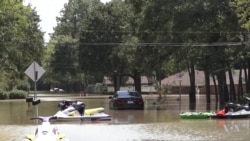From Houston and Miami, to cities in South Asia, 2017 has been a year of intense weather and devastating floods. A combination of climate change and urban development has created a perfect storm for catastrophe.
"We are living in a warmer world. We are living in a world where potentially, hurricanes could be more damaging,” said Bill Patzert, climatologist at NASA's Jet Propulsion Laboratory. “Sea levels are rising. They have risen almost nine inches (22 centimeters) in the last century," he said. Rising sea levels, however, make up only a small fraction of the problem, he said.
“It has the appearance that flooding due to great storms or during the monsoon season over Asia is becoming more severe. So what is really happening is that the population of the planet, especially along the great river valleys of Asia and along the coast, for instance, of the United States, we tend to migrate toward the coasts." Patzert added, "so there is just more infrastructure. There are more people. There is more damage.”
An example is the recent flooding in neighborhoods near dams and levees in the Houston, Texas from Hurricane Harvey.
"It is a symptom of the way that we have not been able to control development and to control where and how developers build," said Kian Goh, assistant professor of urban planning at the University of California, Los Angeles.
Architects and urban planners said many cities in potentially flood-prone areas should rethink how they are built and their relationship with water.
“Many urban designers have acknowledged that leaving out natural systems is actually a big problem and the reasons why these cities are flooding is because we have taken away wetlands; we have paved over rivers, we have largely ignored the interaction between physical and natural systems,” said Goh.
One approach to fight floods is what architects call “passive design.”
“Passive approach, which is effectively what nature has done from the beginning, tries to minimize damage. Or as the Dutch have discovered, the water will be there, but how do you make it design in such a way that when it comes and goes, that recovery is not catastrophic," said Rives Taylor, a long-time Houston resident and architect at Gensler, an architecture, design and planning firm.
"So passive means in a lot of ways, less technology, and more kind of learning from nature,” said Taylor.
“For instance, we could design for more parks that for most of the year it would just be lovely park land that you can play with your kids or just visit, and in the once or twice a year events where it does flood, it is fine. It is a field, it will flood and it will come back,” said Goh.
Another design idea with multiple benefits is building a green roof, "which is good because it also cools the neighborhood, urban heat island, every day, but the roof could slow the water down," said Taylor.
Another factor to consider in designing cities in flood-prone areas is transportation, including looking at cities with a "car culture," such as Houston.
"For every Houston inhabitant, there are between 25 and 30 parking spaces," Taylor continued. "That’s another urban design rethink. Do we need that much parking in this era of Uber and Lyft and autonomous vehicles?"
Goh said studies show that spending money on redesigning and planning a city will show long-term positive results in future rain events.
Planners, however, said since local officials determine how a city is built, it will be up to them to decide how to rebuild after a devastating flood and where the money will come from.









